Microstructure and Electrical Conductivity of Cement Paste Reinforced with Different Types of Carbon Nanotubes
Abstract
1. Introduction
2. Materials and Methods
2.1. Materials
2.2. Methods
2.2.1. Samples Preparation
2.2.2. Microstructure, Hydration and Density
2.2.3. Electrical Conductivity
3. Results and Discussion
3.1. Microstructure, Hydration and Density
3.2. Electrical Conductivity
4. Conclusions
- The specimens reinforced with CNTs are less dense than the plain cement samples due to the increased formation of pores in the CSH gel fraction.
- Electrical conductivity was measured for different cement-based samples including plain cement, 0.02%, 0.05% and 0.1 wt.% of MWCTNs after 30 days of curing. Results show an exponential growth with the amount of MWCNTs due to the formation of a conductive network whose effectiveness improves with the loading of nanotubes. In addition, electrical conductivity of cement-based samples with 0.02 wt.% of SWCNTs was also measured resulting in a very similar value to the pure cement. The morphology of MWCNTs is more effective improving the electrical conductivity than the morphology of SWCNTs.
Author Contributions
Funding
Conflicts of Interest
References
- Peyvandi, A.; Soroushian, P.; Abdol, N.; Balachandra, A.M. Surface-Modified Graphite Nanomaterials for Improved Reinforcement Efficiency in Cementitious Paste. Carbon 2013, 63, 175–186. [Google Scholar] [CrossRef]
- Alrekabi, S.; Cundy, A.; Lampropoulos, A.; Savina, I. Experimental Investigation on the Effect of Ultrasonication on Dispersion and Mechanical Performance of Multi-Wall Carbon Nanotube-Cement Mortar Composites. Int. J. Civ. Environ. Struct. Constr. Archit. Eng. 2016, 10, 306–312. [Google Scholar]
- Xu, S.; Liu, J.; Li, Q. Mechanical Properties and Microstructure of Multi-Walled Carbon Nanotube-Reinforced Cement Paste. Constr. Build. Mater. 2015, 76, 16–23. [Google Scholar] [CrossRef]
- Tian, X.; Hu, H. Test and Study on Electrical Property of Conductive Concrete. Procedia Earth Planet. Sci. 2012, 5 (Suppl. C), 83–87. [Google Scholar] [CrossRef]
- Yunchuan, Z.; Liang, B.; Shengyuan, Y.; Guting, C. Simulation Analysis of Mass Concrete Temperature Field. Procedia Earth Planet. Sci. 2012, 5 (Suppl. C), 5–12. [Google Scholar] [CrossRef]
- Konsta-Gdoutos, M.S.; Batis, G.; Danoglidis, P.A.; Zacharopoulou, A.K.; Zacharopoulou, E.K.; Falara, M.G.; Shah, S.P. Effect of CNT and CNF Loading and Count on the Corrosion Resistance, Conductivity and Mechanical Properties of Nanomodified OPC Mortars. Constr. Build. Mater. 2017, 147 (Suppl. C), 48–57. [Google Scholar] [CrossRef]
- Shang, Y.; Zhang, D.; Yang, C.; Liu, Y.; Liu, Y. Effect of Graphene Oxide on the Rheological Properties of Cement Pastes. Constr. Build. Mater. 2015, 96 (Suppl. C), 20–28. [Google Scholar] [CrossRef]
- Rashad, A.M. Effect of Carbon Nanotubes (CNTs) on the Properties of Traditional Cementitious Materials. Constr. Build. Mater. 2017, 153 (Suppl. C), 81–101. [Google Scholar] [CrossRef]
- Tzounis, L.; Liebscher, M.; Fuge, R.; Leonhardt, A.; Mechtcherine, V. P- and n-Type Thermoelectric Cement Composites with CVD Grown p- and n-Doped Carbon Nanotubes: Demonstration of a Structural Thermoelectric Generator. Energy Build. 2019, 191, 151–163. [Google Scholar] [CrossRef]
- Shao, H.; Chen, B.; Li, B.; Tang, S.; Li, Z. Influence of Dispersants on the Properties of CNTs Reinforced Cement-Based Materials. Constr. Build. Mater. 2017, 131 (Suppl. C), 186–194. [Google Scholar] [CrossRef]
- Cerro-Prada, E.; Pacheco-Torres, R.; Varela, F. Effect of Multi-Walled Carbon Nanotubes on Strength and Electrical Properties of Cement Mortar. Materials 2021, 14, 79. [Google Scholar] [CrossRef]
- Wang, H.; Gao, X.; Liu, J.; Ren, M.; Lu, A. Multi-Functional Properties of Carbon Nanofiber Reinforced Reactive Powder Concrete. Constr. Build. Mater. 2018, 187, 699–707. [Google Scholar] [CrossRef]
- Konsta-Gdoutos, M.S.; Aza, C.A. Self Sensing Carbon Nanotube (CNT) and Nanofiber (CNF) Cementitious Composites for Real Time Damage Assessment in Smart Structures. Cem. Concr. Compos. 2014, 53, 162–169. [Google Scholar] [CrossRef]
- Chaipanich, A.; Nochaiya, T.; Wongkeo, W.; Torkittikul, P. Compressive Strength and Microstructure of Carbon Nanotubes–Fly Ash Cement Composites. Mater. Sci. Eng. A 2010, 527, 1063–1067. [Google Scholar] [CrossRef]
- UNE EN 196-1:2005; Methods of Testing Cement. Part 1: Determination of Strength. AENOR: Madrid, Spain, 2005.
- Talayero, C.; Aït-Salem, O.; Gallego, P.; Páez-Pavón, A.; Merodio-Perea, R.G.; Lado-Touriño, I. Computational Prediction and Experimental Values of Mechanical Properties of Carbon Nanotube Reinforced Cement. Nanomaterials 2021, 11, 2997. [Google Scholar] [CrossRef]
- Páez Pavón, A.; Touriño, L.; Isabel, M.; Asenjo Álvarez, F.; Caballero Montes, J.A.; Cerpa Naranjo, A.; Galindo Muñoz, A.; Alanbari Ali Hassan, M.H.; García Junceda, A. Effect of Single-Walled Carbon Nanotubes on the Physical Properties of Cement Paste. In Proceedings of the ISER 174th International Conference, Barcelona, Spain, 5–8 November 2018; pp. 18–21. [Google Scholar]
- Makar, J.; Margeson, J.; Luh, J. Carbon Nanotube/Cement Composites-Early Results and Potential Applications. In Proceedings of the 3rd International Conference on Construction Materials: Performance, Innovations and Structural Implications, Vancouver, BC, Canada, 22–24 August 2005; pp. 1–10. [Google Scholar]
- Stynoski, P.; Mondal, P.; Marsh, C. Effects of Silica Additives on Fracture Properties of Carbon Nanotube and Carbon Fiber Reinforced Portland Cement Mortar. Cem. Concr. Compos. 2015, 55, 232–240. [Google Scholar] [CrossRef]
- Cui, H.; Yang, S.; Memon, S.A. Development of Carbon Nanotube Modified Cement Paste with Microencapsulated Phase-Change Material for Structural–Functional Integrated Application. Int. J. Mol. Sci. 2015, 16, 8027–8039. [Google Scholar] [CrossRef]
- Makar, J.M.; Chan, G.W. Growth of Cement Hydration Products on Single-Walled Carbon Nanotubes. J. Am. Ceram. Soc. 2009, 92, 1303–1310. [Google Scholar] [CrossRef]
- Payá, J.; Monzó, J.; Borrachero, M.V.; Velázquez, S. Evaluation of the Pozzolanic Activity of Fluid Catalytic Cracking Catalyst Residue (FC3R). Thermogravimetric Analysis Studies on FC3R-Portland Cement Pastes. Cem. Concr. Res. 2003, 33, 603–609. [Google Scholar] [CrossRef]
- Szeląg, M. Mechano-Physical Properties and Microstructure of Carbon Nanotube Reinforced Cement Paste after Thermal Load. Nanomaterials 2017, 7, 267. [Google Scholar] [CrossRef]
- Adhikary, S.K.; Rudžionis, Ž.; Rajapriya, R. The Effect of Carbon Nanotubes on the Flowability, Mechanical, Microstructural and Durability Properties of Cementitious Composite: An Overview. Sustainability 2020, 12, 8362. [Google Scholar] [CrossRef]
- Parveen, S.; Rana, S.; Fangueiro, R.; Paiva, M.C. Microstructure and Mechanical Properties of Carbon Nanotube Reinforced Cementitious Composites Developed Using a Novel Dispersion Technique. Cem. Concr. Res. 2015, 73, 215–227. [Google Scholar] [CrossRef]
- Tragazikis, I.K.; Kordatou, T.Z.; Exarchos, D.A.; Dalla, P.T.; Matikas, T.E. Monitoring the Hydration Process in Carbon Nanotube Reinforced Cement-Based Composites Using Nonlinear Elastic Waves. Appl. Sci. 2021, 11, 1720. [Google Scholar] [CrossRef]
- Irshidat, M.R.; Al-Nuaimi, N.; Rabie, M. Influence of Carbon Nanotubes on Phase Composition, Thermal and Post-Heating Behavior of Cementitious Composites. Molecules 2021, 26, 850. [Google Scholar] [CrossRef] [PubMed]
- Fehervari, A.; MacLeod, A.J.N.; Garcez, E.O.; Aldridge, L.; Gates, W.P.; Yang, Y.; Collins, F. On the Mechanisms for Improved Strengths of Carbon Nanofiber-Enriched Mortars. Cem. Concr. Res. 2020, 136, 106178. [Google Scholar] [CrossRef]
- Chen, J.; Akono, A.-T. Influence of Multi-Walled Carbon Nanotubes on the Hydration Products of Ordinary Portland Cement Paste. Cem. Concr. Res. 2020, 137, 106197. [Google Scholar] [CrossRef]
- Jang, S.-H.; Kawashima, S.; Yin, H. Influence of Carbon Nanotube Clustering on Mechanical and Electrical Properties of Cement Pastes. Materials 2016, 9, 220. [Google Scholar] [CrossRef]
- Yoo, D.-Y.; You, I.; Lee, S.-J. Electrical Properties of Cement-Based Composites with Carbon Nanotubes, Graphene, and Graphite Nanofibers. Sensors 2017, 17, 1064. [Google Scholar] [CrossRef]
- Dalla, P.T.; Dassios, K.G.; Tragazikis, I.K.; Exarchos, D.A.; Matikas, T.E. Carbon Nanotubes and Nanofibers as Strain and Damage Sensors for Smart Cement. Mater. Today Commun. 2016, 8, 196–204. [Google Scholar] [CrossRef]
- Jakubinek, M.B.; Johnson, M.B.; White, M.A.; Jayasinghe, C.; Li, G.; Cho, W.; Schulz, M.J.; Shanov, V. Thermal and Electrical Conductivity of Array-Spun Multi-Walled Carbon Nanotube Yarns. Carbon 2012, 50, 244–248. [Google Scholar] [CrossRef]
- Park, J.G.; Cheng, Q.; Lu, J.; Bao, J.; Li, S.; Tian, Y.; Liang, Z.; Zhang, C.; Wang, B. Thermal Conductivity of MWCNT/Epoxy Composites: The Effects of Length, Alignment and Functionalization. Carbon 2012, 50, 2083–2090. [Google Scholar] [CrossRef]
- Garcia-Macias, E.; D’Alessandro, A.; Castro-Triguero, R.; Pérez-Mira, D.; Ubertini, F. Micromechanics Modeling of the Electrical Conductivity of Carbon Nanotube Cement-Matrix Composites. Compos. Part B Eng. 2017, 108, 451–469. [Google Scholar] [CrossRef]
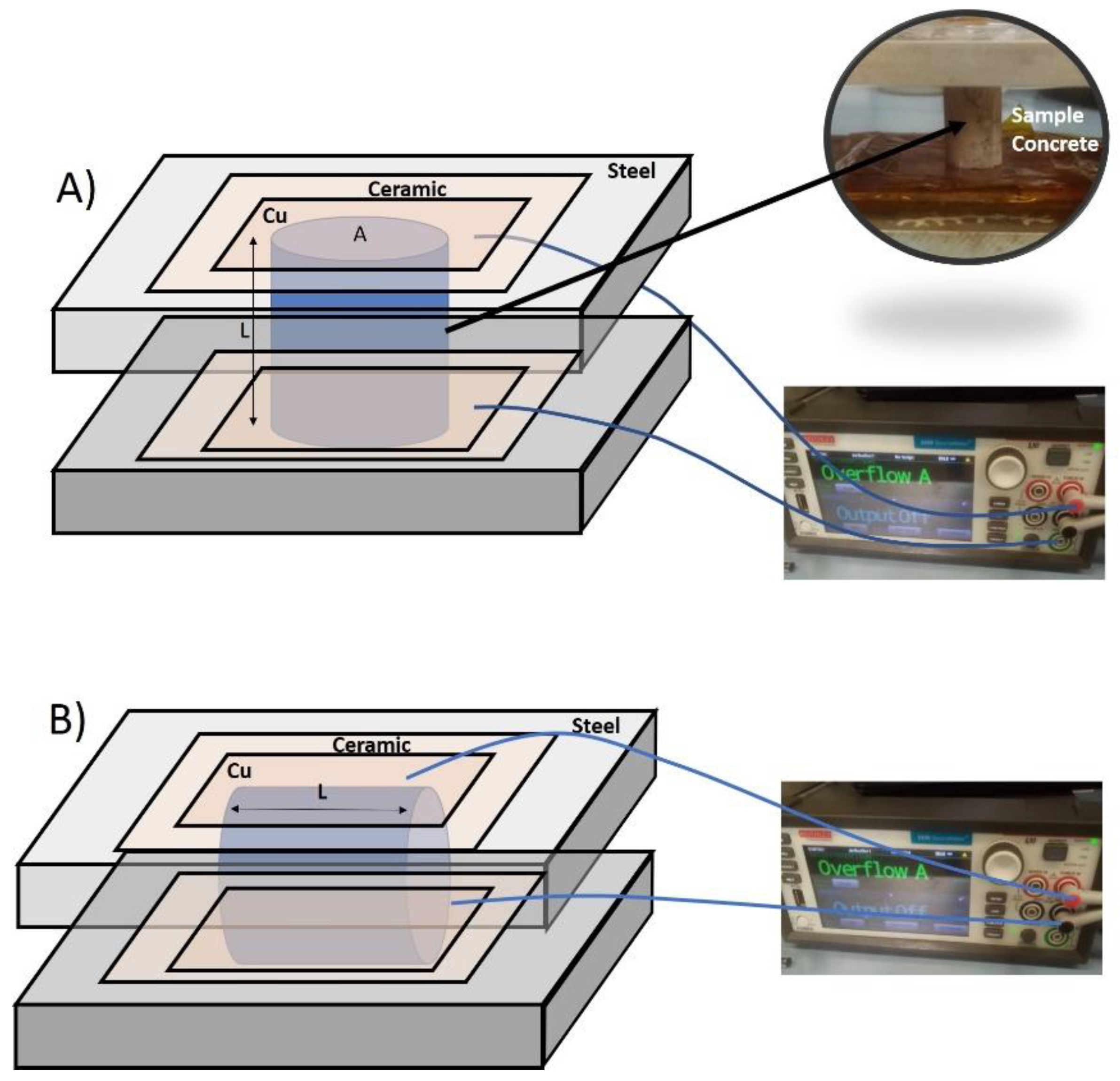



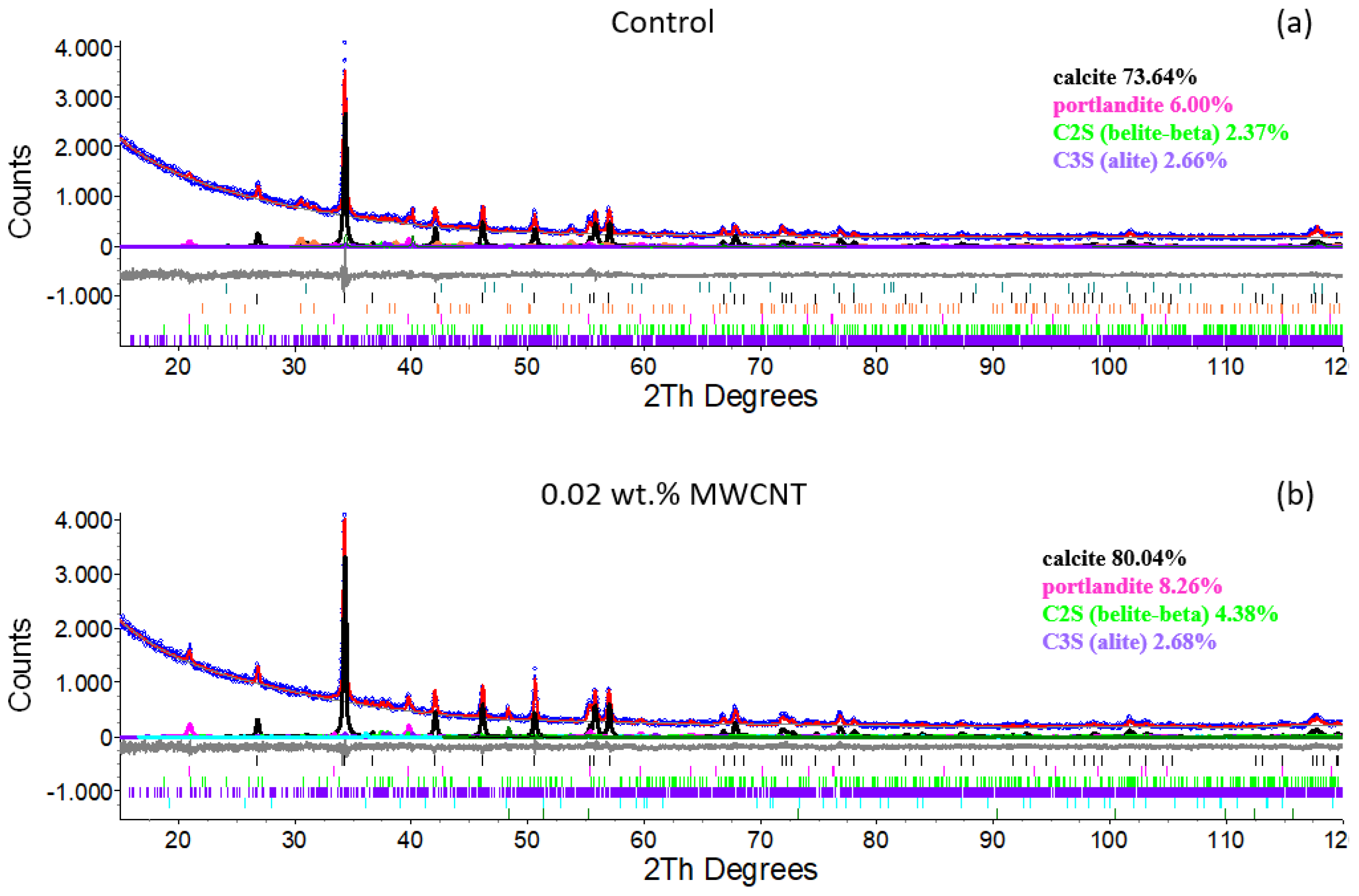
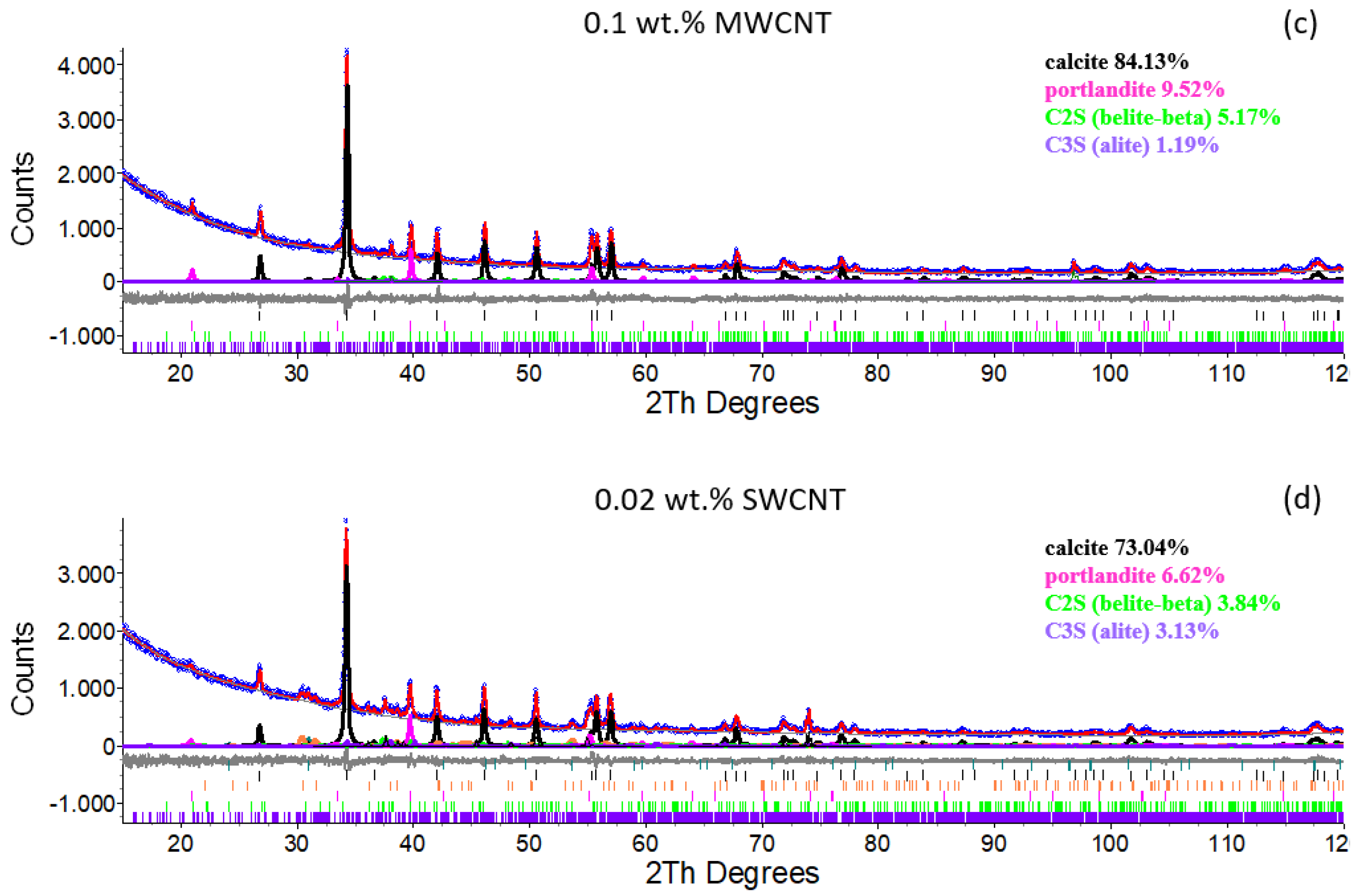
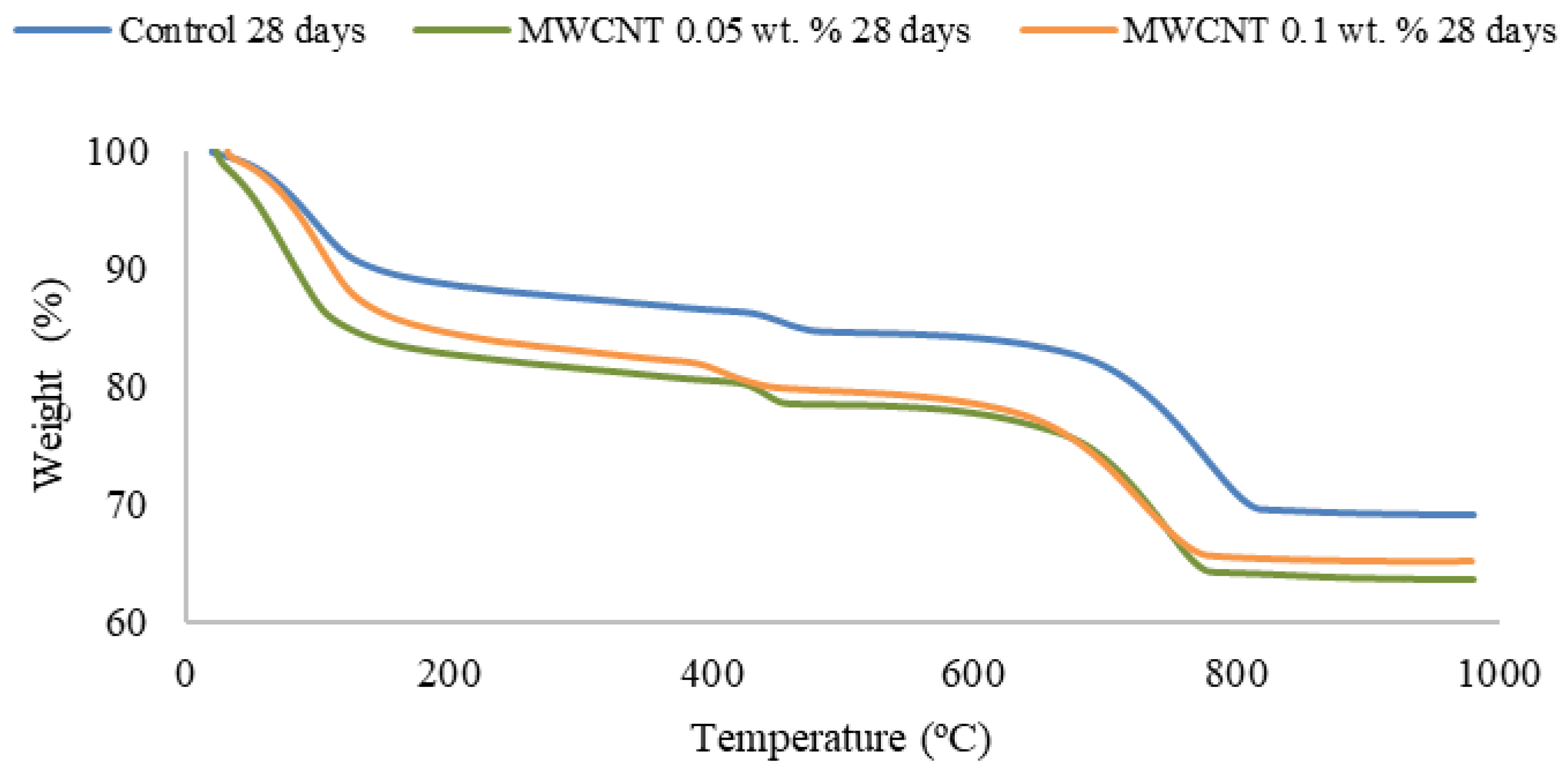
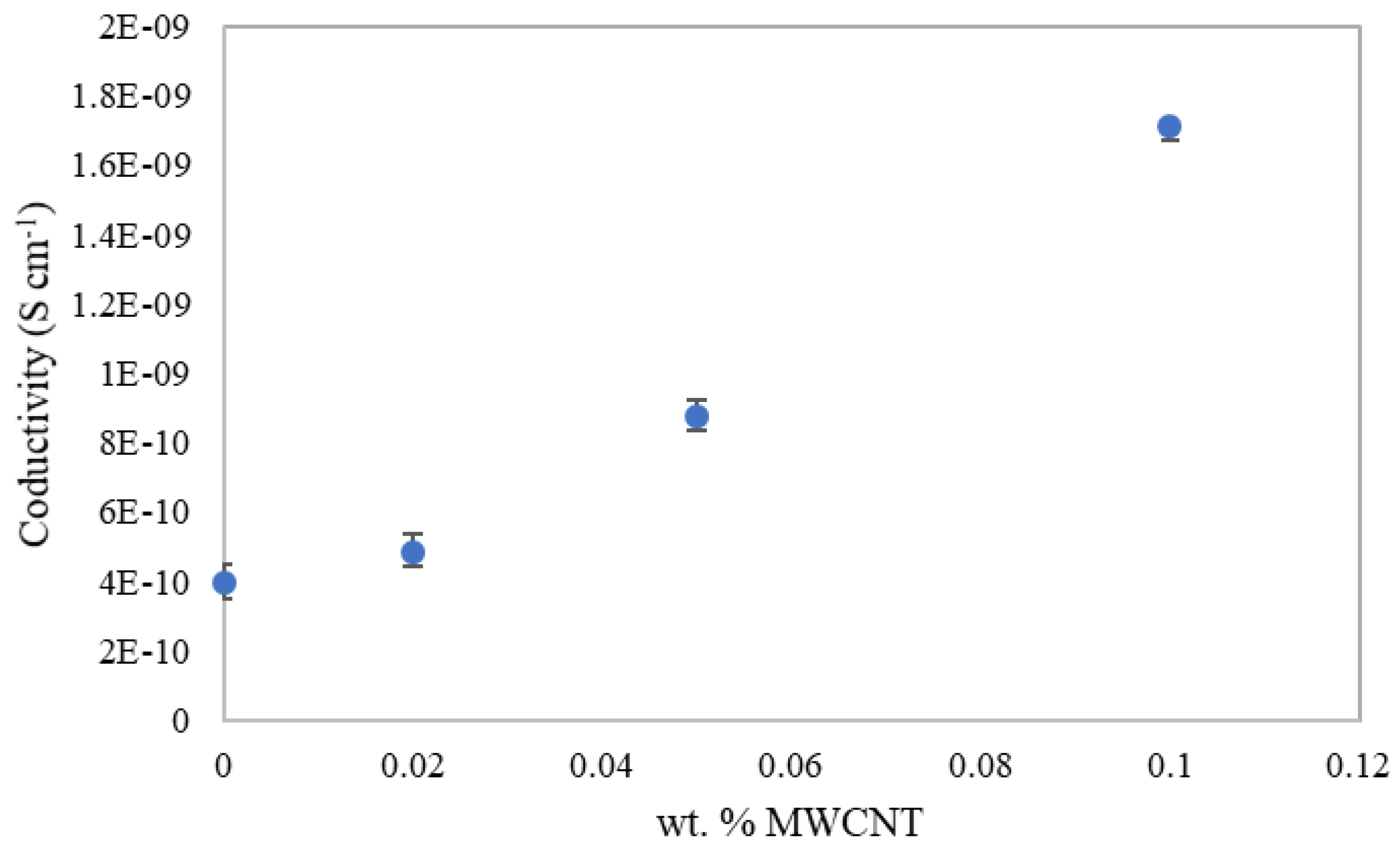
| Component | Amount (wt.%) |
|---|---|
| SiO2 | 12.59 |
| Al2O3 | 3.10 |
| Fe2O3 | 1.94 |
| CaO | 59.04 |
| TiO2 | 0.19 |
| MnO | 0.04 |
| P2O5 | 0.10 |
| SrO | 0.04 |
| MgO | 1.82 |
| K2O | 0.58 |
| SO3 | 2.48 |
| Type of Carbon Nanotube | Average Diameter (nm) | Average Length (µm) | Purity (%) | Provider |
|---|---|---|---|---|
| Multi-walled (MWCNT) | 12 | 10 | >98 | Sigma Aldrich |
| Single-walled (SWCNT) | 0.78 | 1 | >95 | Sigma Aldrich |
| Control | MWCNT 0.02 wt.% | MWCNT 0.1 wt.% | SWCNT 0.02 wt.% | |
|---|---|---|---|---|
| Pycnometer density (g cm−3) | 2.58 | 2.37 | 2.47 | 2.38 |
Publisher’s Note: MDPI stays neutral with regard to jurisdictional claims in published maps and institutional affiliations. |
© 2022 by the authors. Licensee MDPI, Basel, Switzerland. This article is an open access article distributed under the terms and conditions of the Creative Commons Attribution (CC BY) license (https://creativecommons.org/licenses/by/4.0/).
Share and Cite
Páez-Pavón, A.; García-Junceda, A.; Galán-Salazar, A.; Merodio-Perea, R.G.; Sánchez del Río, J.; Lado-Touriño, I. Microstructure and Electrical Conductivity of Cement Paste Reinforced with Different Types of Carbon Nanotubes. Materials 2022, 15, 7976. https://doi.org/10.3390/ma15227976
Páez-Pavón A, García-Junceda A, Galán-Salazar A, Merodio-Perea RG, Sánchez del Río J, Lado-Touriño I. Microstructure and Electrical Conductivity of Cement Paste Reinforced with Different Types of Carbon Nanotubes. Materials. 2022; 15(22):7976. https://doi.org/10.3390/ma15227976
Chicago/Turabian StylePáez-Pavón, Alicia, Andrea García-Junceda, Andrea Galán-Salazar, Rosario G. Merodio-Perea, José Sánchez del Río, and Isabel Lado-Touriño. 2022. "Microstructure and Electrical Conductivity of Cement Paste Reinforced with Different Types of Carbon Nanotubes" Materials 15, no. 22: 7976. https://doi.org/10.3390/ma15227976
APA StylePáez-Pavón, A., García-Junceda, A., Galán-Salazar, A., Merodio-Perea, R. G., Sánchez del Río, J., & Lado-Touriño, I. (2022). Microstructure and Electrical Conductivity of Cement Paste Reinforced with Different Types of Carbon Nanotubes. Materials, 15(22), 7976. https://doi.org/10.3390/ma15227976








